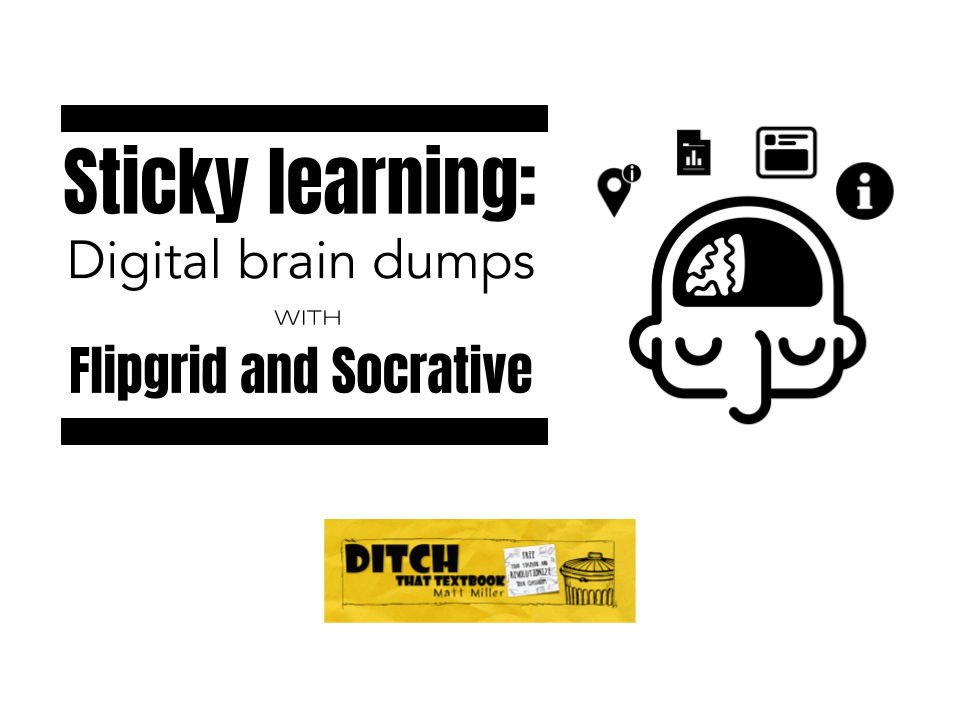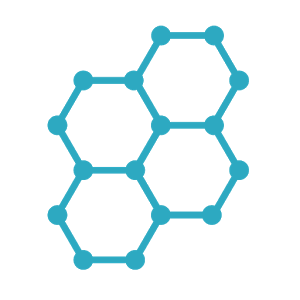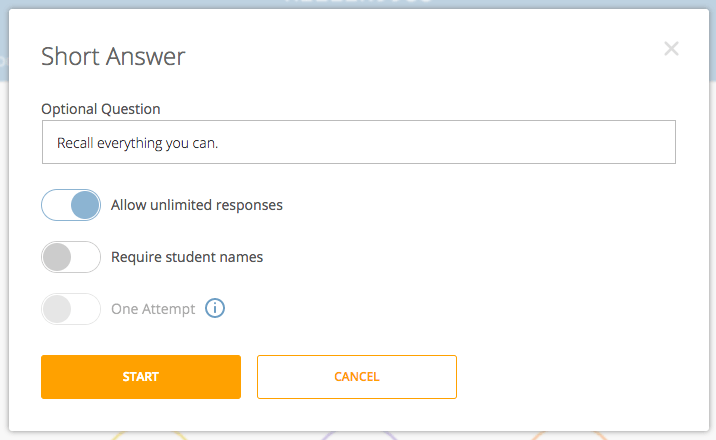
Help new information stick in students' minds with the "brain dump," an effective, low-prep activity in the classroom.
It’s a common request from teachers of students: Study. Go home and study. Go back over the material. Re-read the material.
When we ask students to do this, we mean well. We want them to succeed.
But we’re asking them to study in a way the brain hates.
The problem: the information is flowing in the wrong direction.
As teachers, we’ve been taught to encourage students to study by putting information into the brain. Re-read the chapter. Go back over your notes.
Instead, what our brain really craves is this to pull information from the brain. It’s thing called retrieval, and it leads to better long-term memory.
Retrieval asks students to study by pulling information from the brain — kind of like a dress rehearsal for a quiz or a test. Students write down everything they remember or answer a question like, “Can I restate what I just learned in my own words?”
Research confirms the power of retrieval. In a 2011 study, Jeffrey D. Karpicke and Janell Blunt compared retrieval to another commonly-used study technique: concept mapping. Students using retrieval outperformed students using concept mapping by 50 percent.
(In fact, to prove their point, in a second experiment, they did the same thing but made the final test to create a concept map — putting retrieval practice at a significant disadvantage. Eighty-four percent of students still performed better with retrieval practice than concept mapping.)
Retrieval practice is powerful. It can be an easy practice to incorporate in class. Plus, there are some great digital tools that are made for this kind of practice.
In this post, you’ll learn …
- What a “brain dump” is and how to do it
- How to do video brain dumps with Flipgrid
- How to do text brain dumps with Socrative
- Why you don’t need tech to do brain dumps
- Where you can find more info and research behind brain dumps
Retrieval practice: Using the “brain dump”
Dr. Pooja Agarwal has studied cognitive science through the K-12 lens for years and has focused her study on retrieval practice. Its potential benefits for students of any age or content area are huge.
During her presentation at the Ditch That Textbook Digital Summit, she shared one of her favorite ways to have students use retrieval practice in the classroom.
She called it the “brain dump.”
Here’s a clip from that presentation from the Ditch That Textbook Digital Summit:
Students recall everything they can about a given topic, whether it was covered in the lesson or not. They can do brain dumps in many ways: on paper, verbally to a partner, or digitally.
The benefits from a teacher perspective are huge …
It’s a low-prep activity. There’s virtually no set-up.
It’s a solid strategy that leads to sticky learning, according to the Karpicke research above.
Plus, when you let students do “free recall,” as these brain dumps are called, the teacher isn’t playing “gotcha” by asking for specific answers to specific questions. Students get to show what they know.
There’s one important point to remember when doing brain dumps, Agarwal said in her Ditch That Textbook Digital Summit presentation.
Don’t grade them.
Can I say that again?
Don’t. Grade. Them.
If you want students to use them as an effective study technique, they shouldn’t be graded. Students should be able to practice and let ideas flow freely without having assessment and points lingering in the back of their minds.
Doing brain dumps with Flipgrid
Setting students up to do a brain dump with Flipgrid is almost as low-prep as doing it with paper, and there can be benefits in doing it digitally.
Flipgrid is a tool that lets students respond to a teacher prompt/question with a short video response. You create a grid for your class, add a topic for them to discuss, and share it with students. Students record short video clips and then can view each other’s responses.
To let students do brain dumps via video with Flipgrid, here’s what you do:
1. Create a topic in a Flipgrid grid. Give it a name that fits the activity (i.e. “Biomes brain dump”).
2. Share the topic with students using the blue “share” button. Give students the code, a link to the topic, or share it through Google Classroom, Remind or social media.
3. Have students record their brain dumps. Share this How to use Flipgrid for students video tutorial with your students to show them what to do when they record.
4. When they’re finished, encourage students to go watch each other’s videos to see what other students remembered that they didn’t.
5. Depending on how well students retrieved information, you might ask the class if they heard any information recalled that might be incorrect. As the teacher, you can vet student responses that way, correcting any misconceptions.
Another benefit of retrieving with Flipgrid is that students’ brain dumps are archived and they can come back to them later if they need to.

Doing brain dumps with Socrative
Video brain dumps are a great fit with lots of lessons, content and classes.
However, it may be a better fit to have students type their brain dumps with text.
There are many options for doing this, but a great one is Socrative (socrative.com).
Here’s a really easy way to set up a text-based typed brain dump with students:
1. Go to socrative.com and log in as a teacher. Click on the “Short Answer” type of quick question.
2. Select “Allow unlimited responses”. Decide whether you want student names to appear with their responses. (I prefer not to require student names so students aren’t preoccupied with putting a wrong answer on the screen.) You can type an optional question or leave it blank.
The short answer option in Socrative (socrative.com) lets students submit bits of information individually as part of their brain dump. (Screenshot from Socrative)
3. Invite students to join your Socrative room with the code at the top of your screen. Students go to socrative.com and click the “Student login” button.
4. Have students type and submit each bit of information as its own response. Because they can submit unlimited responses, they can keep dumping all the information they can recall.
5. (OPTIONAL) When they’re finished, click the “Start vote” button. Student responses are then sent to the student devices for voting. Students can vote on the responses that they think are most crucial to know about the topic. (Or, students can cast votes for the information they didn’t remember, which can give great insight to what you might want to reteach!)
Brain dumps don’t require technology
Of course, a simple pencil-and-paper brain dump — or a “turn and talk to your partner” brain dump — can have great benefits as well.
You don’t have to be 1:1 or have the latest technology to use this effective strategy!
For more information about retrieval practice and brain dumps, check out the following links:
- Test-Enhanced Learning: Taking memory tests improves long-term retention
- Free Recall Enhances Subsequent Learning
- The testing effect in free recall is associated with enhanced organizational processes
- Retrieval practice resources, research and more from RetrievalPractice.org
Note: I receive no compensation for mentioning Flipgrid or Socrative in this post in any way. I am a Flipgrid Ambassador but do not receive compensation for that position, nor am I compensated if you use the promo code for a trial of Flipgrid Classroom. I have no relationship of any kind with Socrative.
For notifications of new Ditch That Textbook content and helpful links:
Are you looking for quality, meaningful professional learning that both equips and inspires teachers?
Matt provides in-person and virtual keynotes, workshops and breakout sessions that equip, inspire and encourage teachers to create change in their classrooms. Teachers leave with loads of resources. They participate. They laugh. They see tech use and teaching in a new light. Click the link below to contact us and learn how you can bring Matt to your school or district!
Is Matt presenting near you soon? Check out his upcoming live events!




Love the specific examples that help me better understand what this might look like in an online lesson
[…] Read: Sticky learning: Digital brain dumps with Flipgrid and Socrative […]